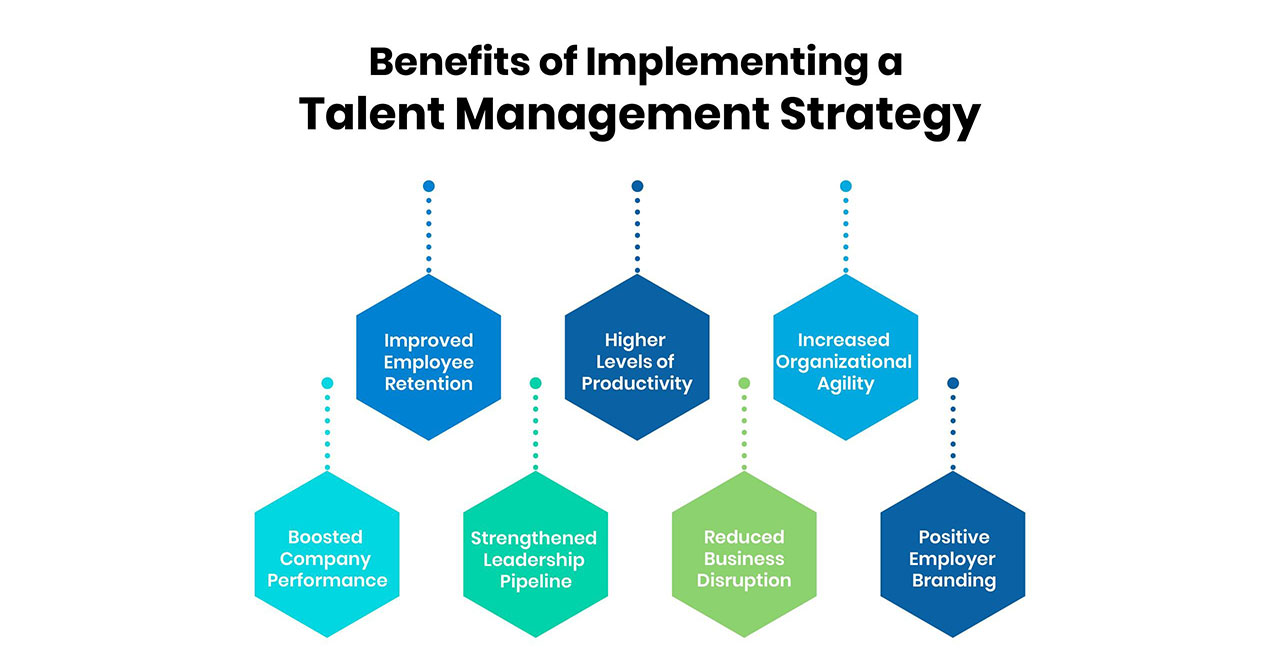
The talent landscape is evolving rapidly, presenting both opportunities and challenges for HR leaders seeking to build future-fit workforces. To stay competitive, organizations must have robust talent management strategies that anticipate and adapt to change.
This blog provides a 12-step framework for constructing a resilient talent management strategy focused on long-term preparation over short-term wins. You'll discover how to spot skill gaps early, nurture leadership potential across all levels, leverage technology for efficiency and insight, and promote inclusivity throughout the employee lifecycle.
Equipped with these future-proofing approaches, HR can drive meaningful progress for both people and organizational success in the years ahead. Let's dive in!
A talent management strategy is a structured plan to optimize an organization's ability to attract, onboard, develop, engage, and retain high-performing employees. It encompasses the full range of human resources processes aimed at maximizing employee productivity and potential in alignment with business objectives.
The core goals of a talent management strategy include improving recruitment and hiring practices to acquire top talent, accelerating new hire onboarding, identifying and addressing skill gaps through training, promoting employee career growth and engagement, and reducing turnover of top performers.
An effective talent management strategy is integrated with wider business aims to give the organization a competitive edge. It focuses on enhancing employee performance to directly impact key success metrics. The strategy is centered on the employee lifecycle, mapping out an optimal journey from initial recruitment through the various stages of employment and career progression within the company.
Key elements in developing a robust talent management strategy involve analyzing strategic business priorities and challenges, studying existing HR processes to identify areas for improvement, connecting talent management initiatives to overarching organizational goals, and investing in supportive infrastructure and systems.
The expected outcomes of successful talent management include boosted retention, increased productivity, upskilled and adaptable workforces, smooth leadership transitions, positive employer branding, and an inclusive company culture that lives the organization's values.
There are multiple valuable benefits to implementing a well-crafted talent management strategy:

This section outlines 12 actionable steps to help organizations attract, develop, and retain the right talent while ensuring agility, inclusivity, and alignment with future business needs.

Collaborating with stakeholders across the business is crucial when designing a talent strategy. Assemble a steering team comprising leaders from key functions like Finance, Operations, Marketing, and Technology to represent diverse viewpoints. Be intentional about including individual contributors and junior managers as well, not just the C-Suite.
This cross-functional group can identify upcoming business objectives, point out potential talent and skill requirements, and provide insights into ground reality. Regular brainstorming sessions allow you to co-create solutions and secure buy-in at every step.
The talent strategy must align with and enable emerging business priorities in your sector. Horizon scanning external trends is an invaluable context for constructing suitable responses.
Track developments across dimensions like technology adoption, customer expectations, market disruptions, competitive moves, and regulatory shifts. How could these impact talent and skills needed in your organization 3-5 years from now? Will certain roles become redundant? What capabilities might give you an edge?
Constant scanning ensures your talent management practices keep pace with external change rather than reacting after the curve.
Once aware of external forces and internal business objectives, the next step is forecasting talent requirements. Start by projecting headcount growth over the next 3-5 years across functions, levels, and geographic locations.
Then layer on skills - which emerging tech, tools, and ways of working will be critical? If you had access to unlimited talent supply, what would your ideal workforce look like? Outcome: A skills taxonomy detailing foundational, differentiated and visionary capabilities needed in the medium term.
The results reveal talent and skill gaps to be addressed through development programs and acquisition channels. They also help prioritize investments in people.
With a view of future talent needs, provide visibility into how employees can progress within the organization. Skills-based career pathways, competency models, and talent mobility options give clarity on:
This empowers people to steer their own growth journey while ensuring critical roles have robust pipelines. This is especially important for high potential middle managers and individual contributors looking to move into leadership.
Leadership continuity is a pressing need most organizations share. Build frameworks to spot high-potential talent early through assessments, multi-rater reviews and career discussions. Customized development solutions can then fast-track their readiness.
High-potential programs, stretch assignments, job rotations, coaching, and mentoring are all effective for nurturing next-gen leaders. Just as crucially, leverage automation and AI where possible to improve succession planning and free up management bandwidth for meaningful development conversations.
Continuous capability building is imperative for organizations racing to close skill gaps amidst constant change. Provide self-paced digital courses focused on emerging skills like design thinking, data literacy, cross-functional collaboration and more.
Complement e-learning with instructor-led programs, workplace learning opportunities like stretch assignments and peer coaching communities. Assessment and certification mechanisms add credibility. The blend of virtual and in-person experiences makes learning perpetual and accessible.
Diverse talent delivers higher innovation and financial performance. All talent management practices must therefore support a wide spectrum of employee needs and perspectives.
Offer programming and assessments in multiple languages, provide captions and interpreters, and communicate clearly on access. Most crucially, equip managers to foster day-to-day inclusion by mitigating bias in decisions and having courageous conversations about barriers faced.
Workforce planning, skills taxonomy creation, personalized learning, and succession planning all create massive data overload. Technology is indispensable for effectively harnessing information at scale.
AI chatbots handle transactional queries, while analytics dashboards with self-service reporting enhance visibility for business partners. Machine learning detects skills adjacencies for better mobility decisions and matches high potentials to opportunities.
Meanwhile, digital assistants schedule meetings and interview candidates around the globe, multiplying recruiting reach. Thoughtfully implementing automation and analytics multiplies HR’s talent strategy impact exponentially.
Instead of transactional hiring into open vacancies, develop pipelines for skills perpetually needed. Proactively map target universities, credentialing partners, associations, competitors, and vendors to source from.
Engage passive candidates through your employee brand and networks. Technology again plays a huge role – programmatic job advertising expands reach while AI sifting of applications accelerates screening.
Getting access to scarce yet critical skills get easier through year-round networking both online and at relevant events.
The nature of work and productivity are transforming drastically. Yet organizations still follow legacy models of annual reviews, ratings and rear-view mirror metrics, leaving employees demotivated.
Focus evaluation on qualitative measures like problem-solving, collaboration, creativity and resilience. Gather multi-source data through tools integrating project management, 1:1 meeting, and pulse surveys. Emphasize development rather than appraisal.
Ongoing coaching conversations remove recency bias to give a balanced view of contributions while increasing agility to deploy talent.
Empowering employees increases engagement, agility, and ownership. Provide mobile access to career development resources, job vacancies, peer networks, benefits information and more.
Chatbots handle basic queries while analytics track usage patterns. Ensure accessibility for frontline workers or employees without company devices.
Self-service gives HR bandwidth to focus on value-add advisory while employees feel more heard and supported.
The workforce strategy must dynamically sync external change with internal capability development across varying time horizons.
Revisit the framework quarterly by re-scanning trends, auditing progress on goals, gathering feedback from stakeholders, and re-prioritizing actions based on new information.
Periodic retrospectives prevent talent management from becoming rigid or reactive. They reinforce foresight and agility to drive strategy excellence.
Constructing an adaptable talent management strategy spanning near-term skill development to long-range leadership succession gives organizations an edge in uncertain times. As technology and operating models force reinvention, workforces most equipped to handle constant change will determine future success.
This 12-step guide offers a blueprint for HR leaders to build such resilient and productive teams. Of course, realizing the vision requires tenacity - venture capital firm Andreessen Horowitz states that “software is eating the world”. Ensure your people's strategies can thrive in the future tech-enabled workplace.
Stay tuned for more insights on helping organizations navigate ongoing talent transformation. The journey promises to be demanding yet incredibly fulfilling for teams embracing their expanded mandate. Onward!
Q. What is a talent management strategy?
A. A talent management strategy is a structured plan that helps organizations attract, onboard, develop, engage, and retain high-performing employees. It aligns HR processes with business objectives to maximize employee productivity and potential throughout the employee lifecycle.
Q. Why is having a talent management strategy important?
A. A well-crafted talent management strategy offers numerous benefits, including improved employee retention, higher productivity levels, enhanced organizational agility, strengthened leadership pipelines, positive employer branding, and reduced business disruptions due to effective workforce planning.
Q. What are the key components of a talent management strategy?
A. The main components include:
Q. What external trends should organizations consider when developing a talent strategy?
A. Understanding external trends helps anticipate future talent and skill requirements. Organizations should monitor trends like technological advancements, evolving customer expectations, market disruptions, competitive dynamics, and regulatory changes.
Q. What role does technology play in talent management?
A. Technology enhances efficiency by:
Q. How often should organizations review their talent strategy?
A. Regular reviews help maintain agility and alignment with organizational needs. Talent strategies should be reviewed quarterly. This involves scanning external trends, auditing progress on key goals, re-prioritizing actions based on feedback and new insights.
Q. What are the outcomes of a future-proof talent management strategy?
A. Organizations can expect:

CredBadge™ is a proprietary, secure, digital badging platform that provides for seamless authentication and verification of credentials across digital media worldwide.
CredBadge™ powered credentials ensure that professionals can showcase and verify their qualifications and credentials across all digital platforms, and at any time, across the planet.

Please enter the License Number/Unique Credential Code of the certificant. Results will be displayed if the person holds an active credential from TMI.